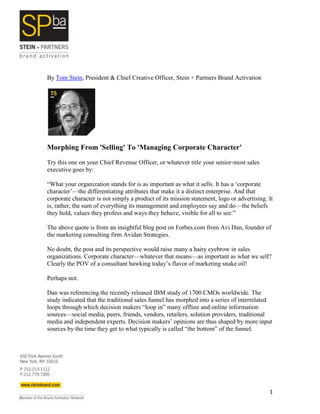Morphing From 'Selling' To 'Managing Corporate Character'
•Télécharger en tant que DOCX, PDF•
0 j'aime•182 vues
CMOs are on top on marketing trends because they are listening and creating data feedback loops across all touch points, and understanding the inter-relationships. They are tracking this through purchase and past purchase. They are measuring brand health holistically with such hard business objectives as sales, share and revenue as the ultimate end goals.
Signaler
Partager
Signaler
Partager

Recommandé
Recommandé
Contenu connexe
En vedette
En vedette (20)
Product Design Trends in 2024 | Teenage Engineerings

Product Design Trends in 2024 | Teenage Engineerings
How Race, Age and Gender Shape Attitudes Towards Mental Health

How Race, Age and Gender Shape Attitudes Towards Mental Health
AI Trends in Creative Operations 2024 by Artwork Flow.pdf

AI Trends in Creative Operations 2024 by Artwork Flow.pdf
Content Methodology: A Best Practices Report (Webinar)

Content Methodology: A Best Practices Report (Webinar)
How to Prepare For a Successful Job Search for 2024

How to Prepare For a Successful Job Search for 2024
Social Media Marketing Trends 2024 // The Global Indie Insights

Social Media Marketing Trends 2024 // The Global Indie Insights
Trends In Paid Search: Navigating The Digital Landscape In 2024

Trends In Paid Search: Navigating The Digital Landscape In 2024
5 Public speaking tips from TED - Visualized summary

5 Public speaking tips from TED - Visualized summary
Google's Just Not That Into You: Understanding Core Updates & Search Intent

Google's Just Not That Into You: Understanding Core Updates & Search Intent
The six step guide to practical project management

The six step guide to practical project management
Beginners Guide to TikTok for Search - Rachel Pearson - We are Tilt __ Bright...

Beginners Guide to TikTok for Search - Rachel Pearson - We are Tilt __ Bright...
Morphing From 'Selling' To 'Managing Corporate Character'
- 1. By Tom Stein, President & Chief Creative Officer, Stein + Partners Brand Activation Morphing From 'Selling' To 'Managing Corporate Character' Try this one on your Chief Revenue Officer, or whatever title your senior-most sales executive goes by: “What your organization stands for is as important as what it sells. It has a „corporate character‟—the differentiating attributes that make it a distinct enterprise. And that corporate character is not simply a product of its mission statement, logo or advertising. It is, rather, the sum of everything its management and employees say and do—the beliefs they hold, values they profess and ways they behave, visible for all to see.” The above quote is from an insightful blog post on Forbes.com from Avi Dan, founder of the marketing consulting firm Avidan Strategies. No doubt, the post and its perspective would raise many a hairy eyebrow in sales organizations. Corporate character—whatever that means—as important as what we sell? Clearly the POV of a consultant hawking today‟s flavor of marketing snake oil! Perhaps not. Dan was referencing the recently released IBM study of 1700 CMOs worldwide. The study indicated that the traditional sales funnel has morphed into a series of interrelated loops through which decision makers “loop in” many offline and online information sources—social media, peers, friends, vendors, retailers, solution providers, traditional media and independent experts. Decision makers‟ opinions are thus shaped by more input sources by the time they get to what typically is called “the bottom” of the funnel. 1
- 2. A by-product is that, if the decision goes in your favor, the decision maker is far more inclined to share broadly his or her experiences with your brand (note the conscious word choice, “brand”—not “product” or “solution”). As a marketer, what does this mean to you? You have a unique opportunity to build shared beliefs and relationships or, conversely, to fail to inspire customers to become brand advocates, says Dan. These are not exactly new thoughts. But the IBM study is revealing: it shows that CMOs from companies that are out-performing—or what we would call “activated brands”—are totally on top of these trends. They are creating what we at SPBA call “digital brand ecosystems” to maintain a ubiquitous, relevant and appropriate presence across the multitude of digital touch points (analog as well, for that matter). They are listening and creating data feedback loops across all these touch points, and understanding the inter-relationships. They are tracking this through purchase and past purchase. They are measuring brand health holistically with such hard business objectives as sales, share and revenue as the ultimate end goals. Perhaps most important, they are starting with purpose—making it very clear what their brand stands for. And, only then, are they drilling down into the value propositions and differentiators that seal the deal. To some in sales, this thinking is going to feel awfully fuzzy, and not quite aligned with the hard work of efficiently hitting targets. I get that. But if you ascribe to the view, as I do and IBM data supports, that the world and the decision-making process have and continue to evolve, then marketers need to focus more on establishing corporate character as a framework for customer relevance and relationships. In answer to the sales (and C-suite) skeptics, the analytics exist to measure this--and, pretty much, everything. Read more: http://www.cmo.com/leadership/morphing-selling-managing-corporate- character#ixzz27aWN6zR8 2
